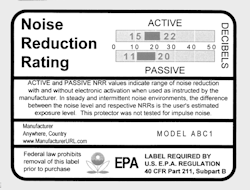Hearing Protection Device (HPD) Attenuation
Attenuation refers to the damping or decrease of noise levels as a result of wearing HPDs. All hearing protectors are provided with an Noise Reduction Rating (NRR).
Noise Reduction Ratings (NRR)
Hearing protectors must adequately reduce the noise level for each employee’s work environment. Most employers use the Noise Reduction Rating (NRR) that represents the protector’s ability to reduce noise under ideal laboratory conditions. The employer then adjusts the NRR to reflect noise reduction in the actual working environment.
Although earplugs can offer protection against the harmful effects of impulse noise, and some earplugs are designed specifically to reduce this type of noise, the NRR is based on the attenuation of continuous noise and may not be an accurate indicator of the protection attainable against impulse noise. Earplugs are better suited for warm and/or humid environments, such as foundries, smelters, glass works, and outside construction in the summer.
Standard Threshold Shift (STS)
OSHA's definition of a standard threshold shift is a change, relative to an earlier baseline hearing test, of 10 dB or more in the average hearing level at 2000, 3000, and 4000 Hz in either ear. For employees who have experienced a standard threshold shift (STS), HPDs must attenuate exposure at or below the action level of 85 dBA-TWA (time-weighted average).
Requirements related to attenuation include:
- The employer must evaluate HPD attenuation for the specific noise environments in which the HPD will be used.
- HPDs must attenuate employee exposure to at least an eight hour time-weighted average of 90 dBA.
- The adequacy of the HPDs must be re-evaluated whenever employee noise exposures increase to the extent that they may no longer provide adequate attenuation. The employer must provide more effective hearing protectors as necessary.
- Employer needs to know and understand the methods for estimating HPD attenuation.
Knowledge Check Choose the best answer for the question.
2-7. HPDs must attenuate employee exposure to at least an eight hour time-weighted average of _____.
You forgot to answer the question!

